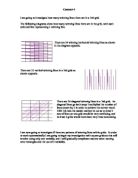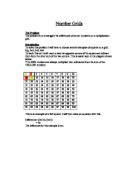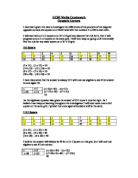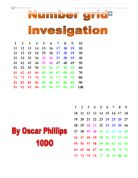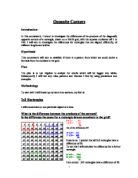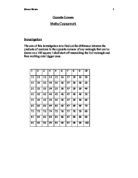Opposite Corners
Louis Franks 10PC 10X2 10/12/01 Opposite Corners Wx L Difference Increase Wx L Difference Increase 2 x 3 20 0 6 x 3 00 50 2 x 4 30 0 6 x 4 50 50 2 x 5 40 0 6 x 5 200 50 2 x 6 50 0 6 x 6 250 50 2 x 7 60 0 6 x 7 300 50 2 x 8 70 0 6 x 8 350 50 2 x 9 80 0 6 x 9 400 50 2 x 10 90 0 6 x 10 450 50 We are investigating the difference between the products of the numbers in the opposite corners of any rectangles that can be put on a 100 square. 2 x 3 Rectangles 2 3 1 2 3 To keep things simple I have started with rectangles with a width of 2 squares. I kept the width to two squares and increased the length by one square. (see results table above). I discovered that the width increases by 10 every time the length increases by 1. The difference can be worked out for all rectangles with a width of 2 squares by using several formulas: . (Length - 1 x 10 = Z) 3 - 1x 10 = 20 = Z Then (Width x Z ) - Z = difference of opposite corners 2 x 20 - 20 = 20 OR 2. L = Length, W = Width (L - 1) (10 (W-1)) = difference of opposite corners Example: (3 - 1) x (10 (2 - 1)) = 20 OR 3. 2 3 1 2 3 Using algebra and going on the theory that the width increases by 10 when the length is increased by 1, I have
investigate how many winning lines there are in a 7x9 grid.
I am going to investigate how many winning lines there are in a 7x9 grid. The following diagrams show how many winning lines there are in the grid, with each coloured line representing 1 winning line. There are 24 winning horizontal winning lines as shown in the diagram opposite. There are 21 vertical winning lines in a 7x6 grid as shown opposite. There are 24 diagonal winning lines in a 7x6 grid. As diagonal lines go both ways I multiplied the number of lines shown by 2 in order to achieve the correct result. I felt this was the easiest method to use as to draw 2 sets of lines on one grid would be very confusing, and to draw 2 grids would have been very time consuming. I am now going to investigate if there are patterns of winning lines within grids. In order to work systematically I am going to begin my investigation with square grids as this will involve using only one variable, and I will gradually complicate matters when moving onto rectangles and the use of 2 variables. Square Grids I am now going to investigate winning lines in square grids. I am going to put my results in a table to enable me to spot any patterns that occur. Winning Lines n (grid size) Horizontal Vertical Diagonal 4 4 4 2 5 0 0 8 6 8 8 8 As we can see horizontal and vertical winning lines are the same in square grids. Horizontal and Vertical Rules The first difference is
Number Grids
Number Grids The Problem The problem is to investigate the differences of corner numbers on a multiplication grid. Introduction To solve this problem I will have to choose several examples of squares on a grid: E.g. 2x2, 3x3, 4x4 To work this out I will need to take the opposite corners of the square and subtract them from the other sum of the two corners. This is easier seen in the diagram shown below: *The RED numbers are always multiplied then subtracted from the sum of the YELLOW numbers. 2 3 4 5 6 7 8 9 0 1 2 3 4 5 6 7 8 9 20 21 22 23 24 25 26 27 28 29 30 31 32 33 34 35 36 37 38 39 40 41 42 43 44 45 46 47 48 49 50 51 52 53 54 55 56 57 58 59 60 61 62 63 64 65 66 67 68 69 70 71 72 73 74 75 76 77 78 79 80 81 82 83 84 85 86 87 88 89 90 91 92 93 94 95 96 97 98 99 00 This is an example of a 2x2 square. I will then make an equation with this: Difference= (2x11)-(1x12) = 10 The difference for this example is ten. 2x2 Squares I will use on grid to use several example of 2x2 squares by placing them randomly on the grid. 2 3 4 5 6 7 8 9 0 1 2 3 4 5 6 7 8 9 20 21 22 23 24 25 26 27 28 29 30 31 32 33 34 35 36 37 38 39 40 41 42 43 44 45 46 47 48 49 50 51 52 53 54 55 56 57 58 59 60 61 62 63 64 65 66 67 68 69
Number Stairs Investigation
Number Stairs Investigation 91 92 93 94 95 96 97 98 99 00 81 82 83 84 85 86 87 88 89 90 71 72 73 74 75 76 77 78 79 80 61 62 63 64 65 66 67 68 69 70 51 52 53 54 55 56 57 58 59 60 41 42 43 44 45 46 47 48 49 50 31 32 33 34 35 36 37 38 39 40 21 22 23 24 25 26 27 28 29 30 1 2 3 4 5 6 7 8 9 20 2 3 4 5 6 7 8 9 0 lowest number (n) Long operation Total (t) st Difference (D0) + 2 + 3 + 11 + 12 + 21 50 6 2 2 + 3 + 4 + 12 + 13 + 22 56 6 3 3 + 4 + 5 + 13 + 14 + 23 62 6 4 4 + 5 + 6 + 14 + 15 + 24 68 6 5 5 + 6 + 7 + 15 + 16 + 25 74 6 Judging by this, the first part of the overall equation for a 3 step stair is 6n +? n 6n T D0 6 50 44 2 2 56 44 3 8 62 44 4 24 68 44 5 30 74 44 This shows the difference between 6n and T as + 44 Therefore the equation for a 3 step stair on a 10x10 grid is 6n + 44 The same sequence can be used for a 4 step stair lowest number (n) Long operation Total (t) st Difference (D0) + 2 + 3 + 4 + 11 + 12 + 13 + 21 + 22 + 31 20 0 2 2 + 3 + 4 + 5 + 12 + 13 + 14 + 22 + 23 + 32 30 0 3 3 + 4 + 5 + 6 + 13 + 14 + 15 + 23 + 24 + 33 40 0 4 4 + 5 + 6 + 7 + 14 + 15 + 16 + 24 + 25 + 34 50 0 5 5 + 6 + 7 + 8 + 15 + 16 + 17 + 25 + 26 + 35 60 0 n 0n T D0 0 20 10 2 20 30 10 3 30 40 10 4 40 50 10 5
Investigate the difference of the product of the diagonally opposite corners of a certain shape, drawn on a 10x10 grid with the individual squares numbered off 1 to 100.
Maths Coursework Aim: I task is to investigate the difference of the product of the diagonally opposite corners of a certain shape, drawn on a 10x10 grid with the individual squares numbered off 1 to 100 I will start off by working this out on a 2x2 square and from there I will begin to investigate varying the length and width of rectangles and other squares. I will aim to investigate the differences for different sized rectangles and squares that are aligned differently on the grid. I will record findings and ideas as I proceed. Method: To make things easier for me I will break up each investigation in to sections, I will start with: 2x2 square I will concentrate on one particular aspect at a time. * What is the difference between the products of the corners? * Is the difference the same for a square or rectangle the same shape anywhere on the grid? 2 3 4 5 6 7 8 9 0 1 2 3 4 5 6 7 8 9 20 21 22 23 24 25 26 27 28 29 30 31 32 33 34 35 36 37 38 39 40 41 42 43 44 45 46 47 48 49 50 51 52 53 54 55 56 57 58 59 60 61 62 63 64 65 66 67 68 69 70 71 72 73 74 75 76 77 78 79 80 81 82 83 84 85 86 87 88 89 90 91 92 93 94 95 96 97 98 99 00 2 x 11 = 22 x 12 = 12 Diff = 10 Are all the differences 10? 46 x 55 = 2,530 45 x 56 = 2,520 Diff = 10 It seems so. I now predict
Borders Maths Coursework
Borders Maths Coursework Here we are look at what happens when you put a (square) border on each side of the original shape. Me starting point will have no borders When I add the borders I put them on each side of the first square and there are 4 borders With the next shape there are now 8 borders. With this shape there are now 12 borders. This shape has 16 borders I can now see a pattern in the number of square, which is that there are 4 more each time. Here is a table to show what I have found. Number of black squares Number of white squares 4 5 8 3 2 25 6 41 20 61 24 Using this I can guess what the next number of white squares will be 20. A you can see there are 20 white cubes. This shape has 24 borders Now I will try to find the nth term for the white cubes (Borders). 1st 2nd 3rd 4th 5th 6th 4 8 12 16 20 24 4 4 4 4 4 The nth term for this is 4n so I wanted to work out how many borders there are the 10th shape I will times 4 by 10 and the number of borders will be 40 Now I will work out the nth term for all the squares in the pictures. Number of square 5 3 25 41 st 2nd 3rd 4th 5 13 25 41 st 8 12 16 2nd 4 4 The nth term for all the cubes is 22n-1. The 10th number will be worked out by 4 times 10 minus 1 which is
To find out what size squares must be cut out of the corners of square and rectangle pieces of card to give the box it would create its optimum volume.
As a class we were given a mathematical problem to solve as our first bit of maths coursework for GCSE, it is called the open box problem. We have been asked to find out what size square we would have to cut out the corner of a piece of card, either square or rectangular, to find the optimum volume of that box. I will start at 1cm³ Square and work up in 1cm³. I would expect the optimum volume to most of the time be in the decimal places so I will have to look at all the decimal places between the highest volume I have and the highest one on one of its sides. During this experiment I will be looking for relationships between the length of the side and the volume of the box. Aim:- To find out what size squares must be cut out of the corners of square and rectangle pieces of card to give the box it would create its optimum volume. Prediction:- I predict that the formulas that I find for the squares will be completely different to the formulas for the rectangles. I predict that after we have found the optimum volume that the volumes after that will drop very rapidly. I also think that the size square that we have to cut out of the corner to create the box will always be quite a low number around two or three because as you cut bigger squares off the corner you lose a lot more card that could be used to make the box bigger, but when you cut a little off the corners you get
China in the 20th Century Sources Questions
Affia Mustafa 11D Modern World Study China in the 20th Century Coursework Assignment 4 . The article, 'Dissidents stalked by Chinese police', describes how, after the Tiananmen Square incident, citizens were literally stalked by the police for 're-education'. Wang Hui, a Chinese citizen, was believed to be taken in by the police because she objected to the unjust arrest of her husband. Her friends have reason to believe that after failure to contact Wang Hui, they could only conclude one thing; the police, following her husband's arrest, had taken her. "...Police began continuous surveillance of Wang Hui, the wife of jailed activist Zhou Guioqiang. Concern for her safety intensified yesterday after she failed to make contact with friends for two days. They fear she could be held by the police." Before the article was written, the citizens had a special 'code' to make sure that the networks of houses located to them were always safe. The method was by telephoning each other at set times during the day. This would make sure that the little 'circle' of friends is still safe from the police. This method was also efficient in a way that if anyone did get taken away then they would be alerted very quickly. This new method of taking the spouse away was relatively new. Before this law was enforced, "Such tactics mark a change in how authorities deal with spouses seeking
I will try to find a formula linking P (perimeter), D (dots enclosed) and T (number of triangles used to make a shape). Later on in this investigation T will be substituted for Q
GCSE Maths Coursework - Shapes Investigation Summary I am doing an investigation to look at shapes made up of other shapes (starting with triangles, then going on squares and hexagons. I will try to find the relationship between the perimeter (in cm), dots enclosed and the amount of shapes (i.e. triangles etc.) used to make a shape. From this, I will try to find a formula linking P (perimeter), D (dots enclosed) and T (number of triangles used to make a shape). Later on in this investigation T will be substituted for Q (squares) and H (hexagons) used to make a shape. Other letters used in my formulas and equations are X (T, Q or H), and Y (the number of sides a shape has). I have decided not to use S for squares, as it is possible it could be mistaken for 5, when put into a formula. After this, I will try to find a formula that links the number of shapes, P and D that will work with any tessellating shape - my 'universal' formula. I anticipate that for this to work I will have to include that number of sides of the shapes I use in my formula. Method I will first draw out all possible shapes using, for example, 16 triangles, avoiding drawing those shapes with the same properties of T, P and D, as this is pointless (i.e. those arranged in the same way but say, on their side. I will attach these drawings to the front of each section. From this, I will make a list of all
Investigate the number of winning lines in the game Connect 4.
Year 11 mathematics coursework - Connect 4 Investigation. This is a winning line in the game Connect 4 on a 4x5 board. Winning lines can be horizontal, vertical or diagonal. Investigate the number of winning lines in the game Connect 4. The task asks for an investigation of the number of Connect 4 solutions in different sized grids. In Connect 4 the rules are that a winning line is a straight line of four connected counters in either a vertical, horizontal or diagonal line. To investigate this I must count the total number of possible winning solutions in a grid. The grid does not have too be any particular size however I will begin my investigation by using small grids, therefore the number of solutions will be smaller and easier to count. My results will be recorded in tables to make it easier to spot any patterns or trends. My aim is to establish formulae's that will enable me too calculate the total number of winning lines for any given grid size. These are the steps I will take to complete the set task: . I will draw a range of differently sized grids and count the total amount of possible winning solutions each has on it, this will aid me in creating a formula. 2. After I have gathered all my results I will record them in tables. 3. Using the table I will look for patterns and possible links. 4. Using the data I have collected I will attempt to calculate a



